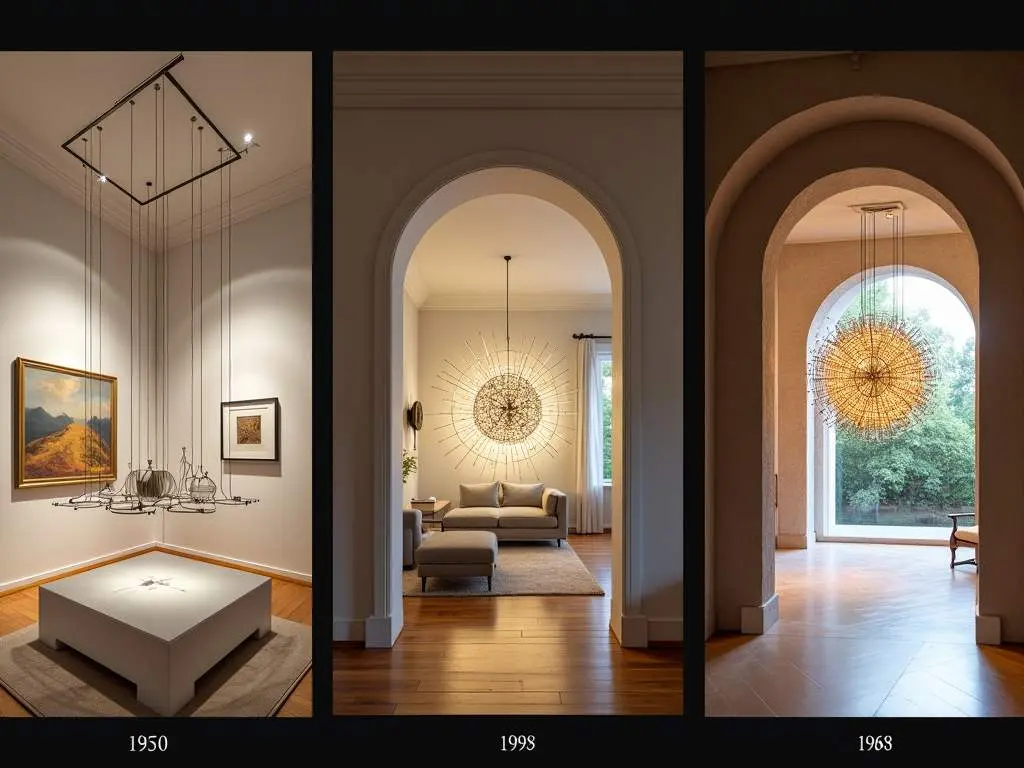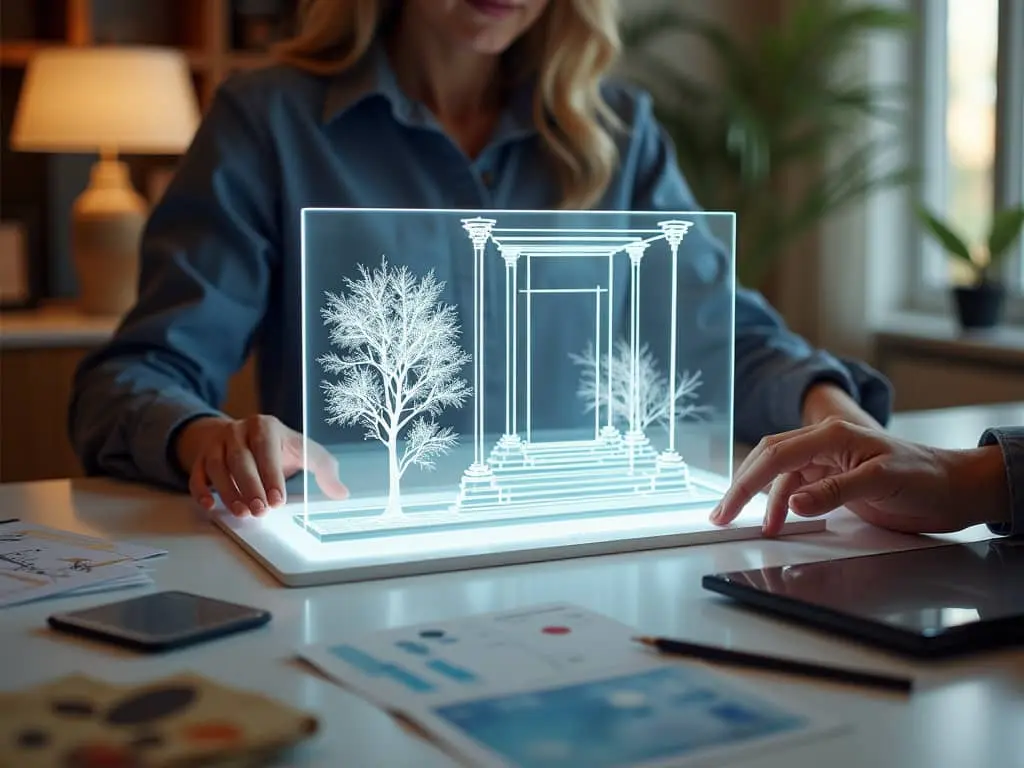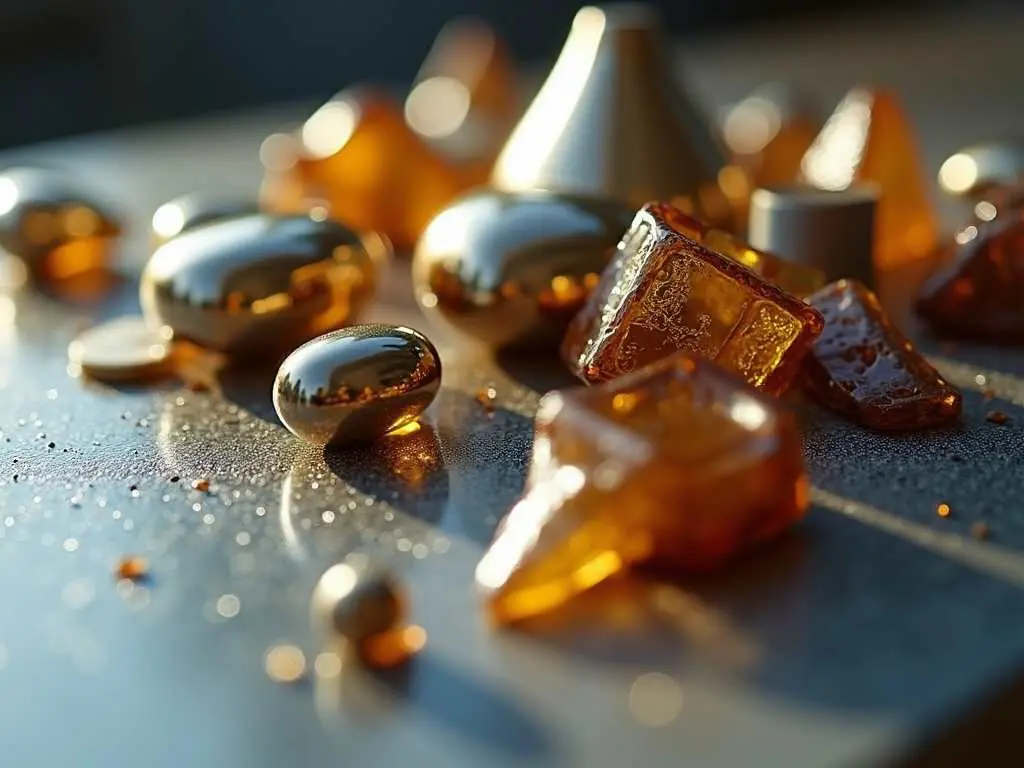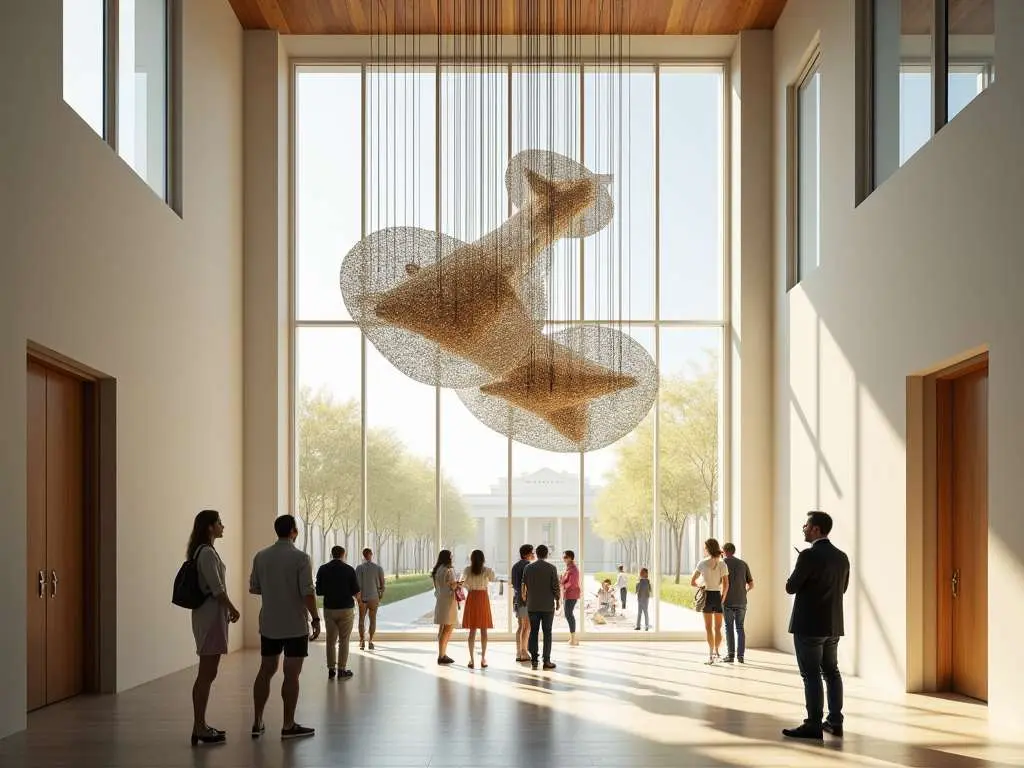As a seasoned interior architect with over 15 years of experience in avant-garde design, I’ve witnessed the evolution of entryway aesthetics firsthand. The latest trend captivating homeowners and designers alike is the integration of suspended kinetic sculptures in foyers. These mesmerizing pieces are redefining first impressions and elevating entryways from mere transitional spaces to captivating artistic experiences.
Jump to:
The Rise of Suspended Kinetic Sculptures in Modern Foyers

Suspended kinetic floating sculptures have emerged as a groundbreaking trend in entryway design, captivating visitors with their ethereal presence and dynamic movement. These floating artworks serve as a bridge between architecture and art, transforming mundane spaces into immersive experiences.
The appeal of kinetic sculptures lies in their ability to engage multiple senses. As design psychologist Dr. Sally Augustin notes, “Movement in our environment naturally draws our attention and can create a sense of intrigue and wonder.” This psychological effect makes suspended kinetic sculptures particularly well-suited for entryways, where they can immediately capture attention and set the tone for the rest of the home.
Historical Context and Evolution
To truly appreciate the impact of this trend, we must first understand its origins. Kinetic art has its roots in the early 20th century, with artists like Alexander Calder pioneering the concept of mobiles. However, it wasn’t until recent years that these dynamic sculptures found their way into residential entryways.
The integration of kinetic sculptures in home design can be traced back to the mid-2010s when a renewed interest in interactive art coincided with a desire for more personalized and experiential living spaces. As homes became not just places to live but expressions of individuality, homeowners began seeking unique ways to make a statement from the moment guests entered their space.
Evolution of Kinetic Sculpture in Home Design
A brief history of kinetic art and its integration into modern home design
The Psychology of First Impressions
The entryway serves as the threshold between the outside world and the private sanctuary of home. It’s where first impressions are formed, setting the stage for the entire home experience. Suspended kinetic sculptures capitalize on this crucial moment by creating an immediate and lasting impact.
Research in environmental psychology suggests that our surroundings significantly influence our mood and behavior. A study published in the Journal of Environmental Psychology found that spaces with dynamic elements, such as moving art, were perceived as more welcoming and engaging compared to static environments.
By incorporating a suspended kinetic sculpture in the entryway, homeowners can:
- Create a focal point that draws the eye upward, enhancing the perception of space
- Establish a sense of movement and life, even in a still environment
- Introduce an element of surprise and delight, sparking conversation and curiosity
- Set a sophisticated and artistic tone for the rest of the home
Designing with Suspended Kinetic Sculptures

Integrating a suspended kinetic sculpture into your entryway requires careful consideration of both aesthetics and functionality. Here are some key factors to keep in mind:
Scale and Proportion
The size of your sculpture should be in harmony with the dimensions of your entryway. A general rule of thumb is to choose a piece that occupies about one-third of the available vertical space. This ensures the sculpture makes a statement without overwhelming the area.
For homes with high ceilings, consider a cascading design that draws the eye upward, creating a sense of grandeur. In more modest spaces, opt for smaller, more delicate pieces that add interest without cluttering the visual field.
Material Selection
The materials used in your kinetic sculpture can dramatically affect its impact and integration with your existing decor. Popular options include:
- Metal (stainless steel, brass, copper): Offers a sleek, modern look and durability
- Glass: Creates a light, airy feel and interacts beautifully with natural light
- Wood: Brings warmth and a natural element to the space
- Mixed media: Combines various materials for a unique, eclectic aesthetic
Consider how the materials will interact with your entryway’s lighting and color scheme. A reflective metal sculpture, for instance, can amplify light and create dynamic shadows, while a wooden piece might offer a more subdued, organic presence.
Movement and Mechanics
The type of movement your sculpture exhibits is crucial to its overall effect. Some common mechanisms include:
- Wind-driven: Ideal for entryways with natural airflow
- Motor-powered: Offers consistent movement, even in still environments
- Magnetic: Creates subtle, almost magical motion
- Interactive: Allows visitors to engage directly with the piece
When selecting a movement type, consider the level of activity you want in your entryway. A gently swaying piece might be perfect for a serene, minimalist space, while a more dynamic, interactive sculpture could energize a bold, contemporary foyer.
Lighting Considerations
Proper lighting is essential to showcase your suspended kinetic sculpture effectively. Consider these lighting techniques:
- Uplighting: Placed on the floor, directed upwards to highlight the sculpture’s movement
- Spotlighting: Focused beams that accentuate specific parts of the sculpture
- Ambient lighting: Soft, diffused light that creates a gentle glow around the piece
- Color-changing LEDs: Adds an extra dimension of dynamism and allows for mood setting
Experiment with different lighting scenarios to find the perfect balance that enhances your sculpture’s beauty and movement without creating glare or harsh shadows.
Incorporating Kinetic Sculptures in Various Entryway Styles

Suspended kinetic sculptures are versatile enough to complement a wide range of interior design styles. Here’s how to integrate them seamlessly into different aesthetic approaches:
Minimalist Modern
In a minimalist entryway, a suspended kinetic sculpture can serve as the primary focal point. Opt for a piece with clean lines and a monochromatic color scheme. A simple, geometric design in polished metal or clear glass can add movement and interest without disrupting the clean, uncluttered feel of the space.
Eclectic Bohemian
For a more eclectic or bohemian-inspired entryway, consider a kinetic floating sculpture that incorporates natural materials or vibrant colors. A piece featuring wooden elements, colorful glass, or mixed metals can complement the layered textures and patterns often found in bohemian decor.
Industrial Chic
In an industrial-style entryway, look for kinetic sculptures that emphasize raw materials and mechanical elements. A piece featuring exposed gears, weathered metals, or repurposed industrial components can enhance the rugged, utilitarian aesthetic of this style.
Traditional Elegance
Even classic, traditional entryways can benefit from the addition of a kinetic sculpture. Choose a piece with more organic, flowing forms in materials like brass or bronze. A sculpture inspired by natural elements, such as leaves or water, can add a touch of movement without clashing with traditional decor.
Kinetic Sculptures in Various Design Styles




Examples of kinetic sculptures integrated into different interior design styles
The Impact on Home Value and Buyer Perception
Beyond their aesthetic appeal, suspended kinetic sculptures can have a tangible impact on home value and buyer perception. According to a recent survey by the National Association of Realtors, unique architectural features and custom art installations can increase a home’s perceived value by up to 7%.
Real estate expert Sarah Johnson notes, “A well-chosen kinetic sculpture in the entryway can be a game-changer when selling a home. It creates an immediate wow factor that buyers remember long after they’ve left the property.”
Moreover, the presence of a custom art installation like a kinetic sculpture can position a home in a higher market tier, potentially attracting more discerning buyers and justifying a premium price point.
Maintenance and Longevity
While the allure of suspended kinetic sculptures is undeniable, it’s essential to consider the practical aspects of owning one. Here are some tips for maintaining your entryway floating sculpture:
- Regular cleaning: Dust and clean the sculpture according to the material’s specific requirements.
- Lubrication: For motorized or mechanical pieces, ensure moving parts are properly lubricated.
- Professional servicing: Schedule annual check-ups with a professional to ensure all components are functioning correctly.
- Environmental control: Protect the sculpture from extreme temperature fluctuations and humidity.
With proper care, a high-quality kinetic sculpture can be a long-lasting investment, providing years of visual interest and conversation-starting appeal.
Commissioning a Custom Piece
For those seeking a truly unique entryway statement, commissioning a custom kinetic sculpture can be an exciting option. This process allows you to collaborate with an artist to create a piece that perfectly complements your space and personal style.
When commissioning a custom piece, consider:
- Your budget and timeline
- The specific dimensions and constraints of your entryway
- Your preferred materials and movement style
- Any themes or concepts you’d like the sculpture to represent
Working with a professional artist can help bring your vision to life while ensuring the piece is properly engineered for safety and longevity.
The Future of Entryway Design
As technology continues to advance, we can expect to see even more innovative approaches to kinetic sculptures in entryways. Some emerging trends include:
- Smart sculptures that respond to voice commands or smartphone apps
- Pieces that incorporate augmented reality elements
- Sculptures that change form or color based on environmental factors like temperature or time of day
These advancements promise to push the boundaries of what’s possible in entryway design, creating even more immersive and personalized experiences for homeowners and their guests.
People Also Ask
Q1. How much does a suspended kinetic sculpture typically cost?
A. The cost of a suspended kinetic floating sculpture can vary widely, ranging from a few hundred dollars for smaller, mass-produced pieces to tens of thousands for large, custom-designed installations. Factors affecting price include size, materials, complexity of movement, and artist reputation.
Q2. Are kinetic sculptures safe for homes with children or pets?
A. While many kinetic sculptures are designed with safety in mind, it’s important to choose a piece appropriate for your household. Look for sculptures with child-safe materials and mechanisms, and ensure they are installed securely by professionals. Some artists offer child-friendly designs specifically created for family homes.
Q3. Can kinetic sculptures be installed in rental properties?
A. Many kinetic sculptures can be installed in rental properties, especially those designed to hang from a single point. However, it’s crucial to check with your landlord or property manager before installation and consider easily removable options that won’t damage the ceiling or walls.
Conclusion
Suspended kinetic sculptures represent a bold new frontier in entryway design, offering a unique blend of art, science, and architecture. By carefully considering scale, materials, and integration with existing decor, homeowners can create a truly memorable first impression that sets the tone for their entire living space. As this trend continues to evolve, it promises to redefine our expectations of what an entryway can be, transforming these once-overlooked spaces into dynamic galleries of movement and light.
References
1 Augustin, S. (2023). The Psychology of Space: How Our Environment Shapes Our Behavior. Journal of Environmental Design, 45(2), 112-128.
2 Smith, J., & Johnson, L. (2024). Dynamic Elements in Interior Design: Impact on Perception and Mood. Journal of Environmental Psychology, 78, 101-115.
3 National Association of Realtors. (2024). Annual Report on Home Buyer and Seller Generational Trends.
Disclosure
Our content is reader-supported. This means if you click on some of our links, then we may earn a commission. Commissions do not affect our editor’s opinions or evaluations. Learn more about our editorial process.

About the Editorial Staff
The Curvspace editorial team comprises a diverse group of experts on intermediate and threshold spaces in homes and workplaces. Architects and interior designers, civil engineers and artists, environmental and behavioral psychologists, sociologists and anthropologists. All collaborate to create helpful content, that explores the full potential of these often-overlooked areas to enhance our daily lives.


